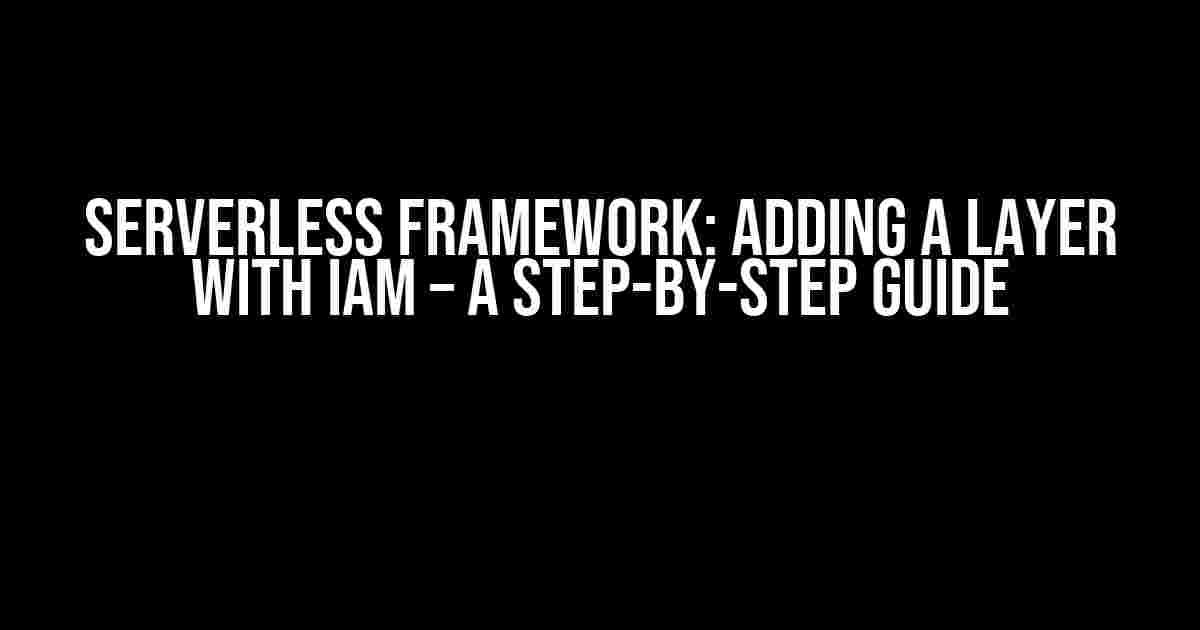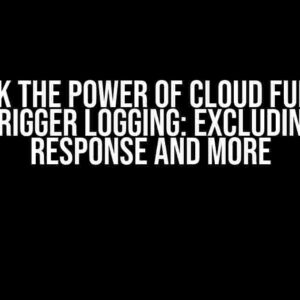Are you tired of managing complex infrastructure for your serverless applications? Do you want to simplify your development process and focus on writing code? Look no further! In this article, we’ll show you how to add a layer with IAM using the Serverless Framework. By the end of this tutorial, you’ll be able to deploy your serverless application with confidence.
What is Serverless Framework?
The Serverless Framework is an open-source framework that enables you to build and deploy serverless applications on cloud providers like AWS, Google Cloud, and Azure. It provides a simple and efficient way to manage your serverless infrastructure, allowing you to focus on writing code rather than managing servers.
What is a Layer in Serverless Framework?
In the Serverless Framework, a layer is a reusable package of code or dependencies that can be shared across multiple functions. Layers are particularly useful when you need to use a specific library or dependency in multiple functions. By creating a layer, you can avoid duplicating code and reduce the size of your function deployments.
Why Use Layers with IAM?
When you use a layer with IAM, you can manage access to your layer using IAM roles. This provides an additional layer of security and control over who can access your layer and its dependencies. By using IAM roles, you can ensure that only authorized users and services can access your layer, reducing the risk of unauthorized access.
Prerequisites
Before we dive into the tutorial, make sure you have the following prerequisites:
- A Serverless Framework project set up and configured
- An AWS account with IAM set up
- The AWS CLI installed and configured
- A basic understanding of IAM roles and permissions
Step 1: Create an IAM Role
In this step, we’ll create an IAM role that will be used to manage access to our layer. Follow these instructions:
- Log in to the AWS Management Console and navigate to the IAM dashboard
- Click on “Roles” in the left-hand menu and then click “Create role”
- Choose “Custom role” and click “Next: Review”
- In the “Role name” field, enter a name for your role (e.g. “LayerExecutionRole”)
- In the “Description” field, enter a brief description of your role
- Click “Create role”
Take note of the role ARN, which will be used later in this tutorial.
Step 2: Create a Layer
In this step, we’ll create a layer using the Serverless Framework. Follow these instructions:
- Open your Serverless Framework project in your preferred code editor
- Create a new file called `layer.js` with the following code:
// layer.js exports.handler = async (event) => { console.log('Hello from the layer!'); return { statusCode: 200 }; }; - Create a new file called `serverless.yml` with the following code:
# serverless.yml service: my-layer provider: name: aws runtime: nodejs14.x layers: my-layer: path: layer.js compatibleRuntimes: - nodejs14.x
This code defines a simple layer that logs a message to the console when executed. We’ll add more functionality to this layer later.
Step 3: Add IAM Permissions to the Layer
In this step, we’ll add IAM permissions to our layer using the `iam` property in the `serverless.yml` file. Follow these instructions:
- Open the `serverless.yml` file and add the following code:
# serverless.yml ... layers: my-layer: path: layer.js compatibleRuntimes: - nodejs14.x iam: role: statements: - Effect: "Execute" Resource: "arn:aws:lambda:*:*:layer:*" roleName: !Sub "LayerExecutionRole-${AWS::Region}" - Update the `roleName` property with the ARN of the IAM role you created in Step 1
This code adds an IAM role to the layer, allowing it to execute with the necessary permissions.
Step 4: Deploy the Layer
In this step, we’ll deploy the layer to AWS using the Serverless Framework. Follow these instructions:
- Open a terminal and navigate to the root of your Serverless Framework project
- Run the command `serverless deploy –layer my-layer` to deploy the layer
This command will deploy the layer to AWS and create a new layer version.
Step 5: Verify the Layer
In this step, we’ll verify that the layer has been deployed successfully and that it’s using the IAM role we created. Follow these instructions:
- Open the AWS Lambda dashboard and navigate to the “Layers” tab
- Find the layer you just deployed and click on it
- Verify that the layer is using the IAM role you created in Step 1
- Verify that the layer is deployed to the correct region and account
If everything is set up correctly, you should see the layer listed in the Lambda dashboard with the correct IAM role and deploy details.
Conclusion
In this tutorial, we’ve shown you how to add a layer with IAM using the Serverless Framework. By following these steps, you can simplify your serverless development process and ensure that your layers are secure and manageable. Remember to update your layer code and IAM permissions as needed to ensure that your layer is functioning as intended.
| Keyword | Description |
|---|---|
| Serverless Framework | An open-source framework for building and deploying serverless applications |
| Layer | A reusable package of code or dependencies that can be shared across multiple functions |
| IAM | AWS Identity and Access Management, a service that provides fine-grained access control and identity management |
| IAM Role | A set of permissions that define what actions can be performed on AWS resources |
By following this tutorial, you’ve taken the first step in mastering the Serverless Framework and building scalable, secure, and efficient serverless applications. Happy coding!
Frequently Asked Question
Serverless Framework adding layer with IAM can be a bit tricky, but don’t worry, we’ve got you covered! Here are some FAQs to help you navigate through the process.
What is a Lambda layer, and why do I need it with Serverless Framework?
A Lambda layer is a ZIP archive that contains libraries, dependencies, or even native libraries that your Lambda function needs to run. With Serverless Framework, you can create and manage your Lambda layers easily, making it a great way to organize and reuse code.
How do I create a new Lambda layer with Serverless Framework?
To create a new Lambda layer with Serverless Framework, you need to define the layer in your `serverless.yml` file. You can do this by adding a `layers` section and specifying the layer name, runtime, and the path to the layer code. Then, run the command `serverless deploy` to deploy the layer.
How do I attach an IAM role to my Lambda layer?
To attach an IAM role to your Lambda layer, you need to specify the role ARN in the `layers` section of your `serverless.yml` file. You can do this by adding the `iamRoleStatements` property and specifying the role ARN. This will allow your Lambda layer to assume the IAM role and access the necessary resources.
Can I use an existing IAM role with my Lambda layer?
Yes, you can use an existing IAM role with your Lambda layer. Simply specify the existing role ARN in the `layers` section of your `serverless.yml` file, and Serverless Framework will use that role when deploying your layer.
What are the benefits of using IAM roles with Serverless Framework?
Using IAM roles with Serverless Framework provides better security and control over your Lambda layers. IAM roles allow you to define fine-grained permissions for your layers, ensuring that they only have access to the necessary resources. This helps to reduce the risk of security breaches and makes it easier to manage your Lambda layers.


